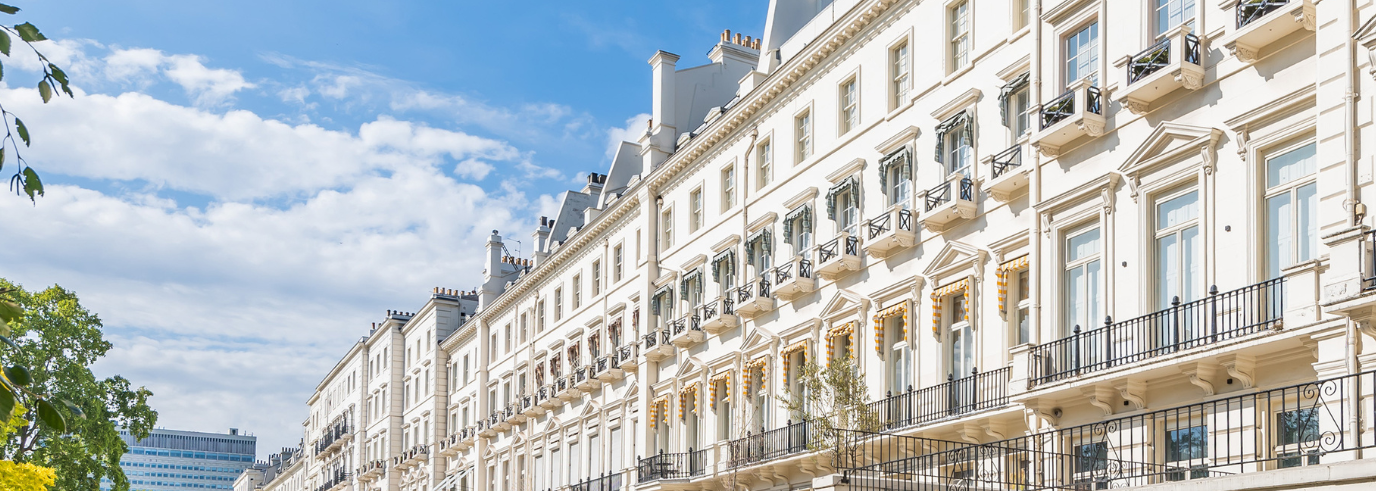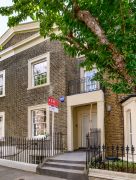
The enduring appeal of Georgian homes
Renowned for their symmetrical façades, sash windows and ornate fireplaces, here's where to find them in the Capital.
7 July, 2023
If you’re a Jane Austen or Bridgerton fan, then you’ll be familiar with the distinctive yet diverse style of architecture and landscaping that is today recognised as Georgian.
The grand country homes of this era featured sweeping drives, serpentine rivers, parkland fringed by trees and gardens often designed or influenced by legendary landscape gardener Capability Brown.
Even the less imposing homes built in England’s towns and cities during this era had a stately feel. Prior to the Georgian period, houses had been small and dark with limited light, but Georgian homes were all about large proportions and big windows – almost exclusively sash – with high ceilings, wooden or marble floors and feature fireplaces.
Their classical style is one of the reasons Georgian homes are regularly voted as the most 'architecturally desirable' properties in the UK, even ahead of those built in the Victorian and Tudor eras.
Argentinian-born, London-based artist Pablo Bronstein summed up the reason for its popularity during his 2017 exhibition ‘Conservatism, or The Long Reign of Pseudo-Georgian Architecture’ at The Royal Institute of British Architects: “Britain is in love with the Georgian [period] because we like to be reminded of the optimism of a growing commercial, industrial and military empire that is now lost. It is an architecture of the golden age, and full of reason and grandeur.”
It was a time of prosperity and many of the homes built during this period were for wealthy people, therefore Georgian property has always been seen as something to aspire to.
What influenced Georgian architecture?
Spanning from 1714 to 1830, the Georgian era covers a time when four successive kings named George sat on the throne in England. It was a period of economic prosperity and patriotism – indeed our National Anthem, ‘God Save the King’, was composed during this time and first performed publicly in London in 1745. Against this backdrop of flourishing fortunes, Georgian architecture boomed, reflecting the prevailing sense of optimism and desire to showcase grandeur and elegance.
“The Georgian era was a time when Britain was taking its place in the world as a leader and much of the architecture harks back to the Palladian style of Italian Renaissance architect Andrea Palladio,” comments KFH Central London Sales Director, Derek Fletcher.
“It was a time of prosperity and many of the homes built during this period were for wealthy people, therefore Georgian property has always been seen as something to aspire to.”
William Kent, a leading architect and designer, and Lord Burlington, an architect and nobleman often referred to as the “Architect Earl", are credited for championing the Anglo-Palladian style. This design style is easily recognised by its columns, symmetry and plain exteriors along with richly decorated and elaborate interiors. Examples can be found at London’s Whitehall, Chiswick House and 10 Downing Street.
As the Georgian era progressed, the range of architecture styles extended to include Gothic, Rococo and the Neo-Classic style adopted by architect John Nash that is reflected in his design of Bloomsbury Square and Regent Street. Consequently, while Georgian properties have some distinct stylised features, the buildings are rarely completely uniform, adding to their desirability as a home.
The most common and popular type of Georgian property found in the UK today is the terrace townhouse, traditionally arranged in long rows (or curves) with accommodation set over three or four storeys. Notable examples include Bedford Square in Bloomsbury, the first uniform square in Georgian London, and Bath’s iconic Royal Crescent, a sweeping arc of 30 Grade I-listed terrace houses lauded as one of the greatest examples of Georgian architecture in the UK.

What key characteristics identify a Georgian property?
- 1
Large sash windows
Properties built during the preceding Tudor and Stuart periods were often small and dark, with tiny windows, but the Georgians were all about large proportions and big windows. Windows in Georgian properties are therefore usually large and typically sash style. However, you may notice smaller windows on the top floor as traditionally this was the servants’ quarters, with the families occupying the lower storeys.
- 2
Bricked-up windows
While the Georgian era was all about light and large proportions, a law was enforced in England between 1696 and 1851 that meant homeowners had to pay a window tax instead of income tax. It was thought that the more windows a home had, the greater the wealth of the owner, so many bricked up some of their windows to reduce the rate of tax they had to pay.
- 3
Decorative interiors
Georgian interiors were extremely decorative, so you’ll often find large ceiling roses made of plaster and elaborate cornicing around high ceilings in main living quarters on lower and middle floors. In larger Georgian properties – particularly those built later in the period – you may also find impressive fire surrounds.
- 4
Symmetry
A key feature of Georgian homes is balance and symmetry, both inside and out, with square rooms of equal size. The front door of a Georgian townhouse usually opens straight onto the road with no porch, while the roof is sometimes hidden behind a parapet to make the building look completely rectangular. A cellar is usually visible from the street below ground level – this may have been traditionally where the kitchen was situated, but today is often converted to a gym, cinema room, snug or wine cellar.
- 5
Stucco exteriors
Georgian homes are usually made of locally-sourced brick or stone (it was pre-railway, so was difficult to transport building material from further afield), but the original brick or stonework is often rendered in plaster, and painted white or cream. You can usually detect when in the Georgian era a property was built by how much stucco is visible. Homes built earlier in the period would usually only have the bottom half rendered, while those built towards the end would be fully rendered.
- 6
Garden squares
Traditional Georgian properties, particularly those in London, either had extremely small gardens, or no gardens at all. So, when they were built, they were arranged around central garden squares that could be used by the property owners. Properties with access to these squares are among some of the most popular in London today.
Where can I find Georgian property to buy or rent in London?
The classical and highly-fashionable homes of the 18th and early 19th century are somewhat harder to come by than their Victorian counterparts and, coupled with their grander proportions, tend to command a premium.
“Many Georgian homes are generational, they are passed down through families and therefore only come onto the market every 25 or 30 years,” adds Derek Fletcher. “And because Georgian homes were built for the wealthy, they are usually found in prime central London locations like Mayfair, Marylebone and Fitzrovia.”
You’ll also find good examples of Georgian property in Islington, Primrose Hill and Regent’s Park in North London and Kensington and Chelsea in West London.
With their timeless beauty and historical significance, Georgian properties continue to captivate and inspire.

Here to help
From Georgian to Victorian architecture, let us help you find your dream property.